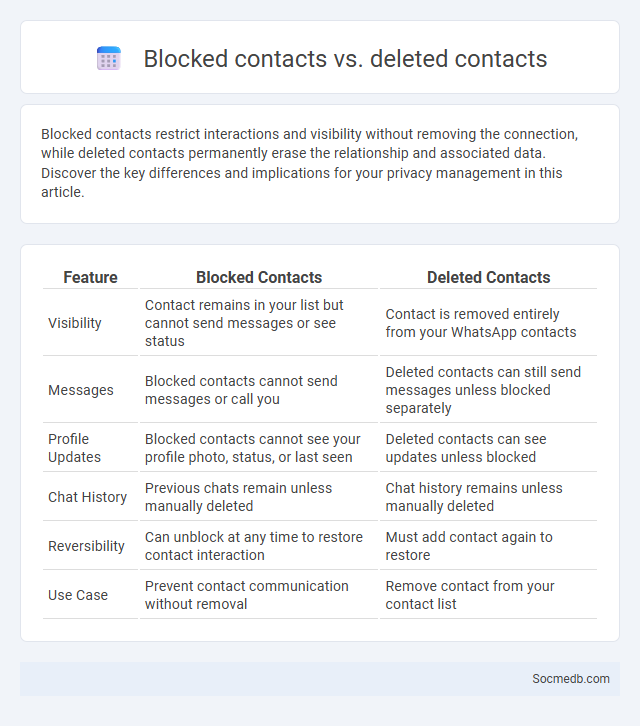
Photo illustration: Blocked contacts vs Deleted contacts
Blocked contacts restrict interactions and visibility without removing the connection, while deleted contacts permanently erase the relationship and associated data. Discover the key differences and implications for your privacy management in this article.
Table of Comparison
| Feature | Blocked Contacts | Deleted Contacts |
|---|---|---|
| Visibility | Contact remains in your list but cannot send messages or see status | Contact is removed entirely from your WhatsApp contacts |
| Messages | Blocked contacts cannot send messages or call you | Deleted contacts can still send messages unless blocked separately |
| Profile Updates | Blocked contacts cannot see your profile photo, status, or last seen | Deleted contacts can see updates unless blocked |
| Chat History | Previous chats remain unless manually deleted | Chat history remains unless manually deleted |
| Reversibility | Can unblock at any time to restore contact interaction | Must add contact again to restore |
| Use Case | Prevent contact communication without removal | Remove contact from your contact list |
Understanding Blocked Contacts
Understanding blocked contacts on social media helps users control interactions by preventing specific accounts from viewing their profiles, posting comments, or sending messages. Platforms like Facebook, Instagram, and Twitter provide settings that enable users to manage their privacy by restricting blocked contacts from accessing personal content. Monitoring and updating blocked lists regularly enhances online safety and minimizes unwanted communication.
What Happens When You Block a Contact
When you block a contact on social media, the person can no longer see your profile, posts, or updates, effectively cutting off all mutual interactions. Messages, comments, and tags from the blocked individual become invisible to you, ensuring your privacy and peace of mind. Your blocked contact will not receive a notification about the block but may notice the absence of your online presence.
Understanding Deleted Contacts
Understanding deleted contacts on social media helps you protect your privacy and maintain control over your digital network. When you remove a contact, their access to your profile and shared content may be limited or completely revoked depending on platform settings. You can review account activity or privacy settings to verify how deletions impact your connections and data visibility.
What Happens When You Delete a Contact
Deleting a contact on social media removes their access to your private posts and stories, limits their ability to message you directly, and often prevents them from seeing your online status or activity. The contact no longer appears in your friend or follower list, and depending on the platform's privacy settings, past interactions like comments or likes may become hidden or removed. This action enhances your control over personal boundaries and digital privacy by restricting unwanted communication and visibility.
Blocked Contacts vs Deleted Contacts: Key Differences
Blocked contacts on social media prevent users from seeing your profile, sending messages, or interacting with your content, maintaining privacy without removing the connection entirely. Deleted contacts remove the person from your friends or followers list, cutting off direct connections but still allowing them to access public content unless further privacy settings are applied. Understanding these differences helps manage online interactions effectively by controlling visibility and communication preferences.
Privacy Implications of Blocking and Deleting
Blocking and deleting on social media platforms significantly impact user privacy by controlling access to personal information and limiting interactions with unwanted contacts. These features help prevent harassment, reduce data exposure, and enhance digital security by restricting who can view posts and profile details. However, privacy risks remain as deleted content may be archived or captured by third parties, necessitating cautious management of digital footprints.
Communication: Blocked vs Deleted Contacts
In social media communication, blocking contacts restricts all interactions and visibility between users, effectively severing digital connections without notification. Deleting contacts removes them from your friend or follower list but often allows continued messaging and content viewing unless additional privacy settings are applied. Understanding these distinctions helps users manage their online interactions more effectively to maintain digital boundaries.
Can Blocked Contacts Reach You?
Blocked contacts on most social media platforms cannot send you messages, view your profile, or interact with your content directly, ensuring your privacy and peace of mind. However, depending on the platform's settings, blocked users might still see your public posts or comments if your profile isn't fully private. To maintain control over your digital presence, regularly review privacy settings and customize who can contact or view your information.
Recovering Blocked and Deleted Contacts
Recovering blocked and deleted contacts on social media platforms often involves accessing the privacy or block list settings, where users can manage and restore connections. Many platforms, such as Facebook and Instagram, allow unblocking contacts, which automatically reinstates the ability to message or view profiles. For deleted contacts, recovery depends on whether the platform supports contact restoration or whether users must manually search and send new connection requests.
Choosing the Right Option: Block or Delete?
Choosing whether to block or delete on social media depends on the nature of the interaction and desired outcome. Blocking restricts unwanted users from viewing your profile or contacting you, providing a more comprehensive form of privacy control. Deleting removes the content or connection but may not prevent future interactions, so blocking is often the preferred choice for lasting protection against harassment or spam.
 socmedb.com
socmedb.com